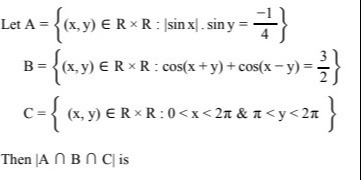Question
Question: Let $A = \left\{ (x, y) \in R \times R : |\sin x|. \sin y = \frac{-1}{4} \right\}$ $B = \left\{ (x,...
Let A={(x,y)∈R×R:∣sinx∣.siny=4−1}
B={(x,y)∈R×R:cos(x+y)+cos(x−y)=23}
C={(x,y)∈R×R:0<x<2π & π<y<2π}
Then ∣A∩B∩C∣ is

A
1
B
2
C
3
D
4
Answer
4
Explanation
Solution
-
Simplify Set B: The identity cos(x+y)+cos(x−y)=2cosxcosy is used. So, 2cosxcosy=23, which simplifies to cosxcosy=43.
-
Combine Conditions from A and B:
- From Set A: ∣sinx∣siny=−41. Squaring both sides gives sin2xsin2y=161.
- Using sin2θ=1−cos2θ, we get (1−cos2x)(1−cos2y)=161.
- Expanding this, we have 1−(cos2x+cos2y)+cos2xcos2y=161.
- From Set B, cosxcosy=43, so cos2xcos2y=(43)2=169.
- Substituting this into the expanded equation: 1−(cos2x+cos2y)+169=161.
- This simplifies to cos2x+cos2y=1+168=23.
-
Solve for cos2x and cos2y:
- Let u=cos2x and v=cos2y. We have the system: u+v=23 uv=169
- These are the roots of the quadratic equation t2−23t+169=0, which is equivalent to 16t2−24t+9=0 or (4t−3)2=0.
- The only solution is t=43. Thus, cos2x=43 and cos2y=43.
-
Derive ∣sinx∣ and siny:
- If cos2x=43, then sin2x=1−43=41, so ∣sinx∣=21.
- If cos2y=43, then sin2y=1−43=41, so ∣siny∣=21.
- Substitute ∣sinx∣=21 into Set A's condition: 21siny=−41, which gives siny=−21. This is consistent with ∣siny∣=21.
-
Find possible values for x and y within Set C:
-
Set C requires 0<x<2π and π<y<2π.
-
For siny=−21 and y∈(π,2π), the possible values for y are y=67π (3rd quadrant) and y=611π (4th quadrant).
-
Case 1: y=67π
- cosy=cos(67π)=−23.
- From cosxcosy=43, we have cosx(−23)=43, so cosx=−23.
- For cosx=−23 and x∈(0,2π), the possible values for x are x=65π and x=67π.
- We must check if ∣sinx∣=21 for these values:
- For x=65π, ∣sin(65π)∣=∣21∣=21. Valid.
- For x=67π, ∣sin(67π)∣=∣−21∣=21. Valid.
- This gives two points: (65π,67π) and (67π,67π). Both satisfy 0<x<2π and π<y<2π.
-
Case 2: y=611π
- cosy=cos(611π)=23.
- From cosxcosy=43, we have cosx(23)=43, so cosx=23.
- For cosx=23 and x∈(0,2π), the possible values for x are x=6π and x=611π.
- We must check if ∣sinx∣=21 for these values:
- For x=6π, ∣sin(6π)∣=∣21∣=21. Valid.
- For x=611π, ∣sin(611π)∣=∣−21∣=21. Valid.
- This gives two points: (6π,611π) and (611π,611π). Both satisfy 0<x<2π and π<y<2π.
-
-
Conclusion:
- In total, there are 4 points in the intersection A∩B∩C: (65π,67π), (67π,67π), (6π,611π), and (611π,611π).
- Therefore, ∣A∩B∩C∣=4.
